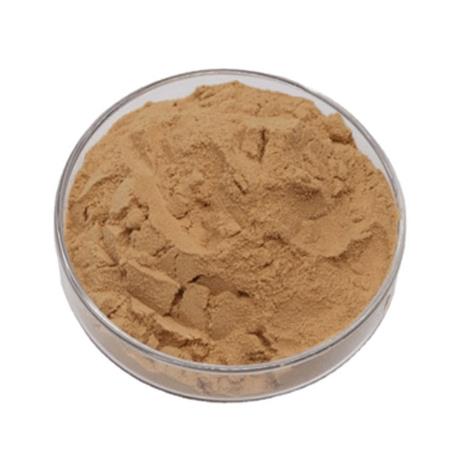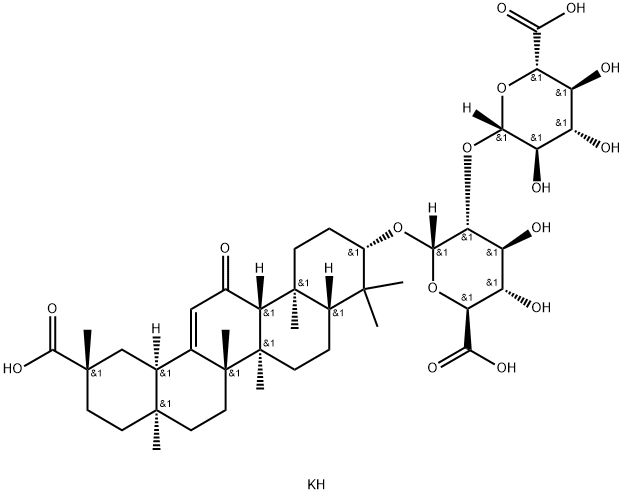Dipotassium Glycyrrhizinate: A Versatile Compound in Pharmaceuticals, Cosmetics, and Beyond
Aug 29,2024
Introduction to Dipotassium Glycyrrhizinate
Dipotassium glycyrrhizinate, a derivative of glycyrrhizic acid, is a chemical compound extracted from the root of the licorice plant (Glycyrrhiza glabra). It is primarily recognized for its extensive use in the pharmaceutical, cosmetic, and food industries due to its potent anti-inflammatory, anti-allergic, and soothing properties. Glycyrrhizic acid, which is the parent compound, has been used for centuries in traditional medicine, particularly in Asia, for its healing properties. Dipotassium glycyrrhizinate, with its enhanced solubility and stability, has gained popularity for various modern applications.

Figure 1 Characteristics of Dipotassium glycyrrhizinate
Physical and Chemical Characteristics
Dipotassium glycyrrhizinate has a melting point in the range of 220-230°C. It is soluble in water and ethanol but insoluble in oils and non-polar solvents, which makes it suitable for use in aqueous formulations. The compound is stable under normal temperature and pressure conditions, though it is sensitive to moisture and should be stored in a dry environment. Its stability across a wide pH range (from mildly acidic to neutral pH levels) makes it an attractive ingredient for various cosmetic and pharmaceutical products.
Biological Activity
One of the most significant features of dipotassium glycyrrhizinate is its biological activity, particularly its anti-inflammatory and soothing effects. It works by inhibiting the production of certain inflammatory mediators, such as prostaglandins and leukotrienes, which play a key role in the inflammatory response. Additionally, it exhibits anti-allergic effects by stabilizing cell membranes and preventing the release of histamine, a major mediator in allergic reactions. Its ability to soothe irritation makes it a popular ingredient in products designed for sensitive or inflamed skin.
Main Components of Dipotassium Glycyrrhizinate
Dipotassium glycyrrhizinate is composed of glycyrrhizic acid as the core component, with two potassium ions replacing hydrogen atoms in its carboxyl groups. Glycyrrhizic acid itself is a saponin glycoside composed of a triterpenoid aglycone (glycyrrhetinic acid) and a disaccharide (glucuronic acid). The dipotassium form enhances the solubility and bioavailability of glycyrrhizic acid, making it more suitable for various applications, especially where water solubility is essential.
Glycyrrhizic acid, the base molecule, is known for its sweetness, being approximately 50 times sweeter than sucrose. This property can influence the taste of the final product, especially in oral formulations. The potassium ions not only improve solubility but also contribute to the neutral pH of the compound, which is important for applications in formulations designed for sensitive skin or mucous membranes.
Uses of Dipotassium Glycyrrhizinate
Pharmaceutical Applications
Dipotassium glycyrrhizinate has found significant use in the pharmaceutical industry, particularly in treatments for conditions involving inflammation, irritation, and allergies. Due to its anti-inflammatory properties, it is commonly included in formulations for treating dermatitis, eczema, and psoriasis. Its ability to inhibit histamine release makes it useful in treating allergic conditions, including rhinitis and asthma.
In addition to its topical applications, dipotassium glycyrrhizinate is also used in oral medications. It is often included in throat lozenges and cough syrups due to its soothing effect on the mucous membranes. Moreover, it has been investigated for its potential use in treating gastrointestinal disorders, such as ulcers and gastritis, because of its ability to reduce inflammation in the stomach lining.
Cosmetic Applications
In the cosmetic industry, dipotassium glycyrrhizinate is widely used in products designed for sensitive or irritated skin. It is commonly found in creams, lotions, and serums targeting conditions like redness, rosacea, and sunburn. Its anti-inflammatory and soothing properties help to reduce redness and irritation, making it a popular ingredient in formulations for sensitive skin.
Moreover, dipotassium glycyrrhizinate is also included in anti-aging products due to its ability to reduce inflammation, which is a contributing factor to the aging process. By minimizing inflammation, it helps to maintain the skin's overall health and appearance. Additionally, it is used in products designed to treat hyperpigmentation and dark spots, as it can inhibit the production of melanin, the pigment responsible for skin color.
Food Industry Applications
While less common than its pharmaceutical and cosmetic uses, dipotassium glycyrrhizinate is sometimes employed in the food industry as a sweetening agent and flavor enhancer. Its sweet taste, derived from glycyrrhizic acid, makes it a potential alternative to sugar in certain food products. However, its use in food is more limited compared to other sweeteners due to potential concerns about excessive consumption, which can lead to side effects such as hypertension.
Other Uses
In addition to its primary applications, dipotassium glycyrrhizinate has been studied for its potential antiviral properties. Research suggests that it may be effective against certain viruses, including hepatitis and herpes viruses. This has led to its inclusion in some antiviral formulations, although further research is needed to fully understand its efficacy in this area.
Storage and Handling of Dipotassium Glycyrrhizinate
Proper storage and handling of dipotassium glycyrrhizinate are essential to maintain its stability and efficacy. The compound should be stored in a cool, dry place, away from moisture and direct sunlight. It is sensitive to moisture, and exposure to humidity can lead to degradation and a decrease in potency. Ideally, it should be kept in a sealed container to prevent exposure to air and moisture.
Dipotassium glycyrrhizinate is stable under normal temperature and pressure conditions, but it should be protected from extreme temperatures, which could affect its physical and chemical properties. In particular, high temperatures can lead to decomposition and a reduction in its effectiveness. When handling the compound, it is important to use appropriate protective equipment, such as gloves and safety goggles, to avoid direct contact with the skin and eyes.
Conclusion
Dipotassium glycyrrhizinate is a versatile compound with a wide range of applications in the pharmaceutical, cosmetic, and food industries. Its anti-inflammatory, anti-allergic, and soothing properties make it a valuable ingredient in products designed to treat various conditions, from skin irritation to gastrointestinal disorders. With its enhanced solubility and stability, dipotassium glycyrrhizinate continues to be an important compound for modern formulations. Proper storage and handling are crucial to maintaining its efficacy, ensuring that it remains a reliable component in various products for years to come.
References:
[1] M TROTTA. Elastic liposomes for skin delivery of dipotassium glycyrrhizinate[J]. International Journal of Pharmaceutics, 2002, 241 2: 203-397. DOI:10.1016/S0378-5173(02)00266-1.
[2] CAMILA DOS SANTOS LEITE. Effects of dipotassium glycyrrhizinate on wound healing.[J]. Acta cirurgica brasileira, 2021, 36 8. DOI:10.1590/ACB360801.
- Related articles
- Related Qustion
Supplementation with pyridoxal 5'-phosphate monohydrate can synthesize neurotransmitters such as dopamine and serotonin, maintaining a healthy nervous system.....
Nov 4,2025Biochemical EngineeringMethyltrimethoxysilane has attracted widespread attention in various chemical industries due to its extensive applications.....
Aug 29,2024APIDipotassium glycyrrhizinate
68797-35-3You may like
Dipotassium glycyrrhizinate manufacturers
- Dipotassium glycyrrhizinate
-

- 2025-12-18
- CAS:68797-35-3
- Min. Order:
- Purity: 0.99
- Supply Ability:
- Dipotassium glycyrrhizinate
-

- $0.00 / 1kg
- 2025-12-18
- CAS:68797-35-3
- Min. Order: 1kg
- Purity: ≥98% UV
- Supply Ability: 1000kg
- Dipotassium glycyrrhizinate
-

- $0.00 / 1Kg/Bag
- 2025-12-18
- CAS:68797-35-3
- Min. Order: 1KG
- Purity: 95%min
- Supply Ability: 8000kg/month






